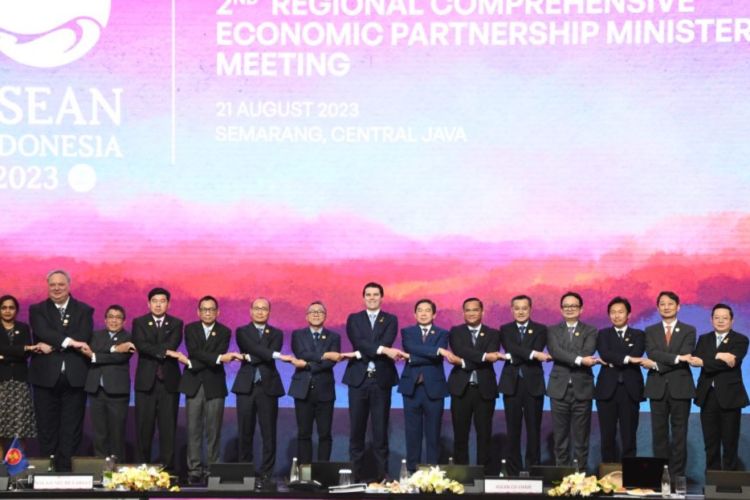While India continues to maintain a cautious stance on joining the Regional Comprehensive Economic Partnership (RCEP), the NITI Aayog seems to be in favour of New Delhi joining the China-led trade bloc to boost trade opportunities. NITI Aayog CEO BVR Subrahmanyam’s recommendation follows the Economic Survey 2024, which advocated integrating India into China’s supply chain. Nevertheless, senior government officials emphasise the importance of understanding the sensitivities involved in trading with neighbouring countries.
The RCEP is a free trade agreement between 10 ASEAN members — Brunei, Cambodia, Indonesia, Malaysia, Myanmar, Singapore, Thailand, the Philippines, Laos, and Vietnam — and six other nations including China, Japan, South Korea, Australia, and New Zealand. Joining RCEP would effectively create a free trade agreement with China, a move India has been cautious about, even after six years of negotiations.
READ | Powell’s Fed vs Trump’s playbook: Can the US economy handle the risk
Why is India wary
India’s apprehension stems largely from its significant trade deficit with China, which reached over $85 billion in FY2024. Joining RCEP could further worsen this deficit. All RCEP members have seen their trade deficits with China rising, indicating that the agreement has primarily benefited China.
NITI Aayog officials argue that India has not fully leveraged the ‘China-plus-one’ strategy, which seeks to diversify manufacturing hubs away from China. In contrast, countries like Vietnam, Indonesia, Malaysia, Turkey, and Mexico have capitalised on this strategy and benefitted significantly.
Influence of US policies
The recent US elections may also influence India’s trade strategy. Donald Trump has criticised India’s high tariffs, even calling the country a tariff king. In exchange for mitigating potential US tariffs on imports from China, India may face pressure to reduce tariffs and grant the US increased market access, especially in agriculture.
India’s high tariff policy has drawn criticism from free trade advocates, who argue that reducing tariffs is essential to participate in global trade meaningfully. The increased tariffs on industrial and agricultural goods in recent years have fuelled this debate.
India’s FTAs with RCEP members
Although India has refrained from joining RCEP, it has free trade agreements with most of the bloc’s members. Negotiations with New Zealand for an FTA are underway, and discussions for a Comprehensive Economic Cooperation Agreement (CECA) with Australia are in advanced stages. Additionally, the Economic Cooperation and Trade Agreement with Australia is already operational.
The World Bank has also recommended that India consider joining RCEP to boost trade, investment, and GDP growth. The World Bank’s recent India Development Update cited the potential for significant economic gains if India joined the trade bloc.
Despite these recommendations, India’s hesitation is grounded in data showing that China’s FTA partners have experienced mounting trade deficits. ASEAN’s trade deficit with China, for example, increased from $81.7 billion in 2020 to $135.6 billion in 2023. South Korea is also likely to record its first-ever trade deficit with China this year. These trends support India’s concerns about the uneven benefits of RCEP, which could result in unfair competition and adversely impact domestic industries.
Alternatives to RCEP
India already enjoys FTAs with 13 of RCEP’s 15 members, excluding China and New Zealand. For India to join the bloc, China would need to address India’s concerns regarding its trade practices, including market transparency and the potential influx of subsidised goods, which could harm India’s domestic industries. India remains wary of cheap Chinese imports flooding its markets, and without substantial reforms from Beijing, an RCEP partnership seems untenable.
Instead, India could focus on other trade partnerships, such as finalising comprehensive FTAs with key markets like the United Kingdom and the European Union to expand market access. Regional groupings like SAARC and BIMSTEC, alongside ongoing negotiations with the Gulf Cooperation Council (GCC) countries and African nations, also offer significant growth potential.
Another consideration is the risk of increased dependency on China in light of ongoing geopolitical tensions. By holding back on RCEP, India preserves autonomy in its supply chains, which enhances its ability to respond assertively to potential adversarial actions from China. Ensuring self-sufficiency in critical areas allows India to protect its economic interests and maintain a strategic stance in the region.
India’s approach to RCEP is therefore shaped by a careful balancing of trade opportunities and strategic autonomy. For now, India’s existing trade agreements and alternative partnerships offer viable paths for growth, while RCEP remains a cautious consideration contingent upon meaningful reforms in China’s trade practices.

